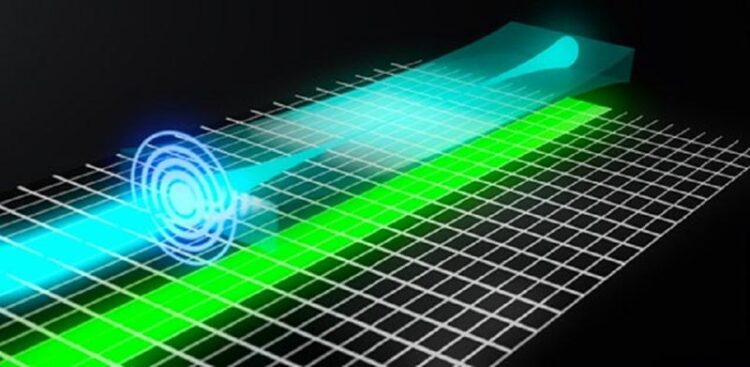Photon-efficient volumetric imaging with light-sheet scanning fluorescence microscopy

When the scanning light-sheet is synchronized with the rolling shutter, pixel reassignment helps to achieve photon-efficient volumetric imaging.
Credit: Liang Qiao (SUSTech)
New method harnesses image scanning superresolution for enhanced photon efficiency in light-sheet microscopy.
In biological imaging, researchers aim to achieve 3D, high-speed, and high-resolution, with low photobleaching and phototoxicity. The light-sheet fluorescence microscope (LSFM) helps meet that aim. Based on a unique excitation and detection scheme, the LSFM can image live specimens with high spatiotemporal resolution and low photobleaching. It has shown great potential for 3D imaging of biological samples.
The principle of LSFM technology is to illuminate the sample with a thin light-sheet and then collect the emitted fluorescence along the axis perpendicular to the transmission of the light-sheet. Therefore, only fluorophores close to the focal plane are excited and detected. Using a thinner light-sheet improves the axial resolution, while a longer light-sheet improves the field of view (FoV) and imaging speed. Tradeoffs are required, as it is difficult to generate a thin, uniform light-sheet.
Multiple light-sheets can be tiled to generate a virtual light-sheet with a higher aspect ratio. However, multiple beams also introduce sidelobes, decreasing the axial resolution and optical sectioning. Axially swept light-sheet microscopy (ASLM) uses a slit to reject the sidelobes. It uses the rolling shutter of the sCMOS, which naturally serves as a slit, to synchronize beam scanning. ASLM can image an arbitrarily large FoV with optimal axial resolution. However, the fluorescence signal outside the rolling shutter will be rejected, so a larger FoV comes at the price of lower photon efficiency.
A research team from the UTS–SUSTech Joint Research Centre for Biomedical Materials Devices recently developed a photon-efficient method to enlarge the FoV. As reported in Advanced Photonics Nexus, the team adopted a superresolution imaging technique, image scanning microscopy (ISM), to develop ISM-enhanced laterally swept light-sheet microscopy (iLSLM). In iLSLM, a “light needle” is first generated by scanning a focused beam axially. When the image of the light needle is captured, pixel assignment is applied to generate a virtual thinner light-sheet. Afterward, the “light needle” is laterally scanned to form a complete light-sheet. Unlike the slit, the pixel assignment improves the optical sectioning and axial resolution without sacrificing photon efficiency.
The researchers found that both iLSLM and ASLM are much better than the conventional swept focus light-sheet (SFLM) in axial resolution and optical sectioning, and iLSLM outperforms ASLM when >55% photon efficiency is required. However, the current work of iLSLM is based on digital pixel reassignment, which significantly reduces the imaging speed. In the future, the researchers will explore optical pixel reassignment to achieve the same imaging speed as ASLM. Meanwhile, iLSLM will be suitable for applications where photobleaching is a severe problem, or the specimen is susceptible to phototoxicity.
Read the Gold Open Access article by L. Qiao, H. Li, S. Zhong, et al., “Laterally swept light-sheet microscopy enhanced by pixel reassignment for photon-efficient volumetric imaging,” Adv. Photon. Nexus 2(1), 016001 (2022), doi 10.1117/1.APN.2.1.0160001.
Journal: Advanced Photonics Nexus
DOI: 10.1117/1.APN.2.1.016001
Article Title: Laterally swept light-sheet microscopy enhanced by pixel reassignment for photon-efficient volumetric imaging
Article Publication Date: 5-Dec-2022
Media Contact
Daneet Steffens
SPIE–International Society for Optics and Photonics
daneets@spie.org
Office: 360-685-5478
All latest news from the category: Physics and Astronomy
This area deals with the fundamental laws and building blocks of nature and how they interact, the properties and the behavior of matter, and research into space and time and their structures.
innovations-report provides in-depth reports and articles on subjects such as astrophysics, laser technologies, nuclear, quantum, particle and solid-state physics, nanotechnologies, planetary research and findings (Mars, Venus) and developments related to the Hubble Telescope.
Newest articles

Cost-effective, high-capacity, and cyclable lithium-ion battery cathodes
Charge-recharge cycling of lithium-superrich iron oxide, a cost-effective and high-capacity cathode for new-generation lithium-ion batteries, can be greatly improved by doping with readily available mineral elements. The energy capacity and…

New regulator of eating behaviour identified
The rapidly escalating prevalence of overweight and obesity poses a significant medical challenge worldwide. In addition to people’s changing lifestyles, genetic factors also play a key role in the development…

Harnessing Machine Learning for Breakthroughs with High-Power Lasers
A team of international scientists from Lawrence Livermore National Laboratory (LLNL), Fraunhofer Institute for Laser Technology ILT, and the Extreme Light Infrastructure (ELI) collaborated on an experiment to optimise high-intensity…





















